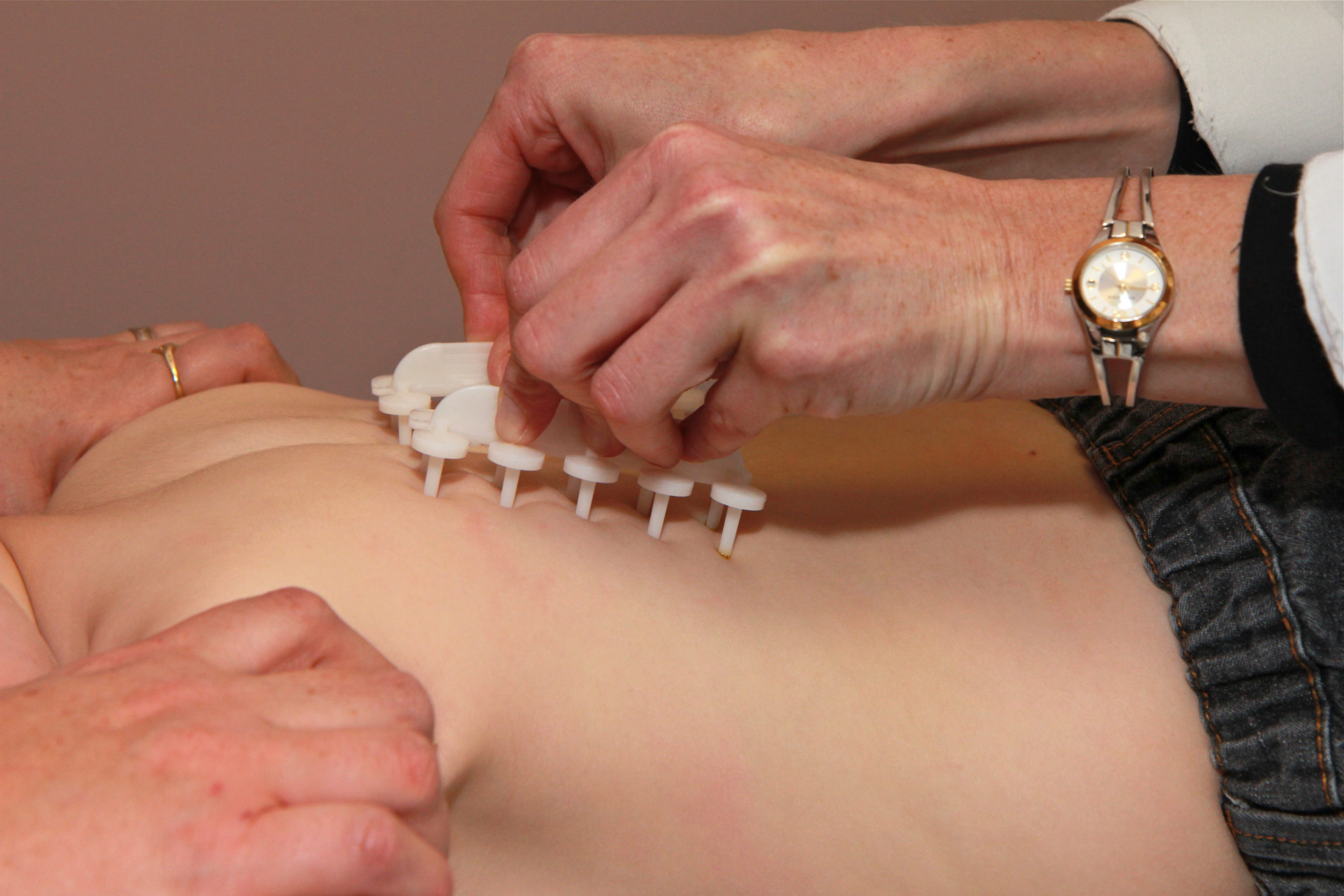Skin Testing
- Skin Prick Testing is one of the most effective and highly specific tests to determine if a person has environmental, food, or venom allergens. At our clinic, we have a screening panel for pediatric and environmental allergens. We also have a more comprehensive panel to test for over 80 food and 52 environmental allergens. Our venom panel includes testing for the honey bee, wasp, yellow jacket, white-faced, and yellow-faced hornets.
- What to Expect: Our allergen panels are typically applied to your back or arms depending on the number of pricks. You will feel some pressure and a slight pinch at most. The pricks are non-invasive which means they do not fully pierce the skin or cause any bleeding and are usually applied ten at a time as opposed to individually which minimizes any level of discomfort. Results are obtained 15 min after application. After just a few minutes you will begin to feel some itching in the areas where your skin is reacting to the specific allergen, often resulting in a small red bump. Our physicians will measure the size of these bumps after the 15-minute period to help assess how severe an allergy may be. These reactions are short-term and often resolve after a small application of corticosteroid cream and an oral antihistamine which we provide after the test.
- How to Prepare: we recommend that patients stay off all antihistamines at least 5 days prior to their skin prick testing visit. This includes a combination of antihistamine tablets, nasal sprays, and eye drops. Some antidepressants and supplements may also contain antihistamines.

Click here to see the full list of Medications to Stop Prior to Skin Testing.
Please call our office if there are any questions.
Conditions diagnosed by skin-prick testing:
- Food Allergies
- Oral Allergy Syndrome
- Eosinophilic Esophagitis
- Anaphylaxis
- Angioedema
- Latex Fruit Syndrome
- Allergic Rhinitis (commonly known as hay fever)
- Asthma
- Urticaria (Hives)
- Atopic Dermatitis
- Chronic Sinusitis
- Chronic Cough
- Intradermal Testing is a more sensitive test compared to skin prick testing. It provides a more detailed insight to help diagnose environmental and venom allergens. It involves an injection of a small amount of allergen under the skin’s surface and within 15 min a wheal and flare reaction may occur for individuals who are allergic. This reaction does quickly resolve with the application of a topical steroid and taking an oral antihistamine.
- What to Expect: intradermal testing is applied only to the arms and typically is only conducted after skin prick testing has already been administered and the more specific indication is required. Intradermal testing is slightly more invasive and consists of a very small injection of the diluted allergen right under the skin’s surface. This forms a small raised bump, and if your body reacts to the allergen, a similar wheal and flare response to the skin prick testing is displayed. The same as skin-prick testing, intradermal testing reactions are short-term and often resolve after a corticosteroid cream application or oral antihistamine.
- How to Prepare: we recommend that patients stay off all antihistamines at least 5 days prior to their skin prick testing visit. This includes a combination of antihistamine tablets, nasal sprays, and eye drops. Some antidepressants and supplements may also contain antihistamines.

Click here to see the full list of Medications to Stop Prior to Skin Testing.
Please call our office if there are any questions. Additionally, if you have a fear of needles, please inform our team so we can ensure we keep you as comfortable as possible during your testing session.
Conditions Diagnosed by Intradermal Testing:
- Allergic Rhinitis (commonly known as hay fever)
- Asthma
- Articaria (Hives)
- Atopic Dermatitis
- Ahronic Sinusitis
- Anaphylaxis
- Angioedema
- Chronic Cough
- Prick-Prick Testing is an effective method to diagnose a specific type of food allergy called oral allergy syndrome whereby due to cross-reactivity between pollens with certain fruits, vegetables, grains, and nuts patients commonly develop itching to the mouth when consuming raw versions of these foods. Patients bring in the particular fruit or vegetable they are allergic to and we prick the actual food and then prick the skin and wait 15 min to see if there is any localized reaction.
- What to Expect: since prick-prick testing is often done to a small number of fruits or vegetables that we need to check sensitivity for, it is conducted on the forearm or back. Similar to skin-prick testing, a small, non-invasive, prick is used to first poke the allergen on the surface and then to prick the skin to expose the skin directly to the allergen. If there is a positive reaction, a wheal and flare reaction develops, which often looks like a small red bump with some symptoms of redness or itchiness. The reaction subsides quickly with the help of corticosteroid cream and an antihistamine tablet.
- How to Prepare: we recommend that patients stay off all antihistamines at least 5 days prior to their skin prick testing visit. This includes a combination of antihistamine tablets, nasal sprays, and eye drops. Some antidepressants and supplements may also contain antihistamines.

Click here to see the full list of Medications to Stop Prior to Skin Testing.
Please call our office if there are any questions. Additionally, the patient is responsible for bringing the fruit or vegetable in question which is then properly washed and disinfected by our team. Our physicians will discuss this with you prior to testing.
Conditions diagnosed by Prick-Prick Testing:
- Food Allergies
- Oral Allergy Syndrome
- Urticaria
- Anaphylaxis
- Angioedema
- Latex Fruit Syndrome
Our physicians have curated a comprehensive patch testing panel to test for some of the most common chemicals including metals and ones found in cosmetics. We employ chemicals suggested by the North American Contact Dermatitis Society in addition to much more. The patch is non-invasive and is placed on a patient’s back that involves 2 visits for the reading of results in the same week after application. After identifying the allergen in question, we also provide you a PDF file that is sub-categorized with a thorough list of products you are able to purchase that will not contain these chemicals.
- What to Expect: our patches are made of a non-allergic adhesive material with individual wells that contain the different allergens we are testing. The patch is applied to the back, similar to a sticker or band aid. Depending on which allergens you are testing for, you may test for one or multiple patches at once. Regardless of the number of patches applied, the process takes up to 3 days, with one day dedicated to application and a separate follow-up appointment the same week to check for reactions. Because the reactions must be observed over this 3 day duration, you may not shower or exercise during this time. Patients may purchase an optional PatchProtect adhesive that gives the patient the ability to do low intensity exercise or take a light shower during the week of chemical patch testing for an out-of-pocket fee. Positive reactions will typically be characterized by some redness, erythema, or small bumps. The severity of these reactions helps determine exactly how severe the allergy may be.

How to Prepare: It’s best for patients to schedule patch test applications when they are able to come back for appointments easily and avoid exercise, profuse sweating, and showers (though sponge baths that avoid the back are permitted).
Conditions diagnosed by Patch Testing:
- Cosmetic Allergies
- Chemical Allergies
- Metal Allergies
- Urticaria
- Dermatitis